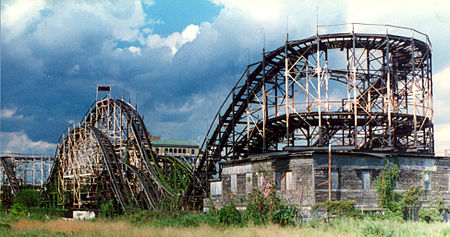Thunderbolt (1925 roller coaster)
1925 establishments in New York City1982 disestablishments in New York (state)Amusement ride stubsBrooklyn building and structure stubsConey Island ... and 7 more
Demolished buildings and structures in BrooklynFormer roller coasters in New York (state)Removed roller coastersRoller coasters introduced in 1925Roller coasters that closed in 1982Use mdy dates from February 2020Wooden roller coasters

The Thunderbolt was a wooden roller coaster located at Coney Island in Brooklyn, New York. Designed by John Miller, it operated from 1925 until 1982 and remained standing until it was demolished in 2000.In June 2013, it was announced that a new steel roller coaster would be constructed on Coney Island named the Thunderbolt. The steel coaster opened in 2014 and uses a completely different design. The demolition was controversial, as the property owner Horace Bullard was not notified, nor had any formal inspection been done on the structure.
Excerpt from the Wikipedia article Thunderbolt (1925 roller coaster) (License: CC BY-SA 3.0, Authors, Images).Thunderbolt (1925 roller coaster)
Surf Avenue, New York Brooklyn
Geographical coordinates (GPS) Address Phone number Website Nearby Places Show on map
Geographical coordinates (GPS)
| Latitude | Longitude |
|---|---|
| N 40.573888888889 ° | E -73.9825 ° |
Address
Luna Park
Surf Avenue 1000
11224 New York, Brooklyn
New York, United States
Open on Google Maps










